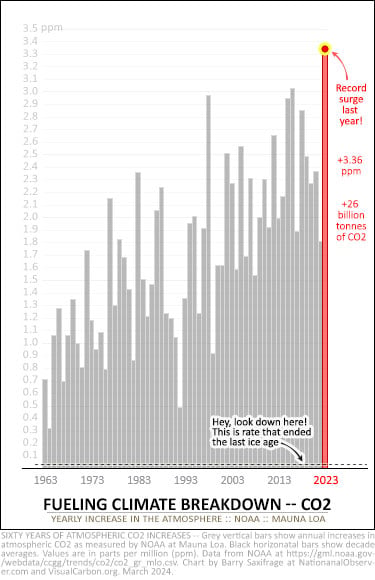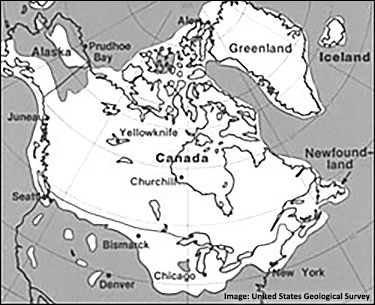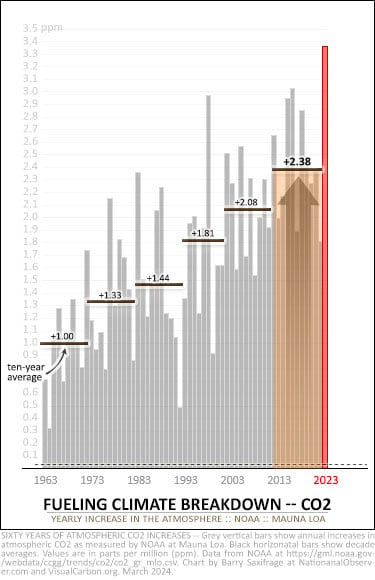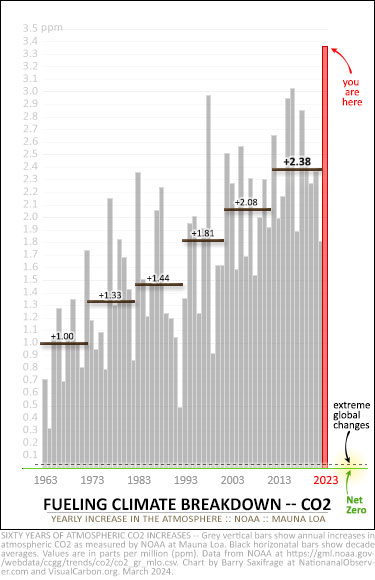Articles Menu

Mar. 27, 2024
“The accumulation of CO2 in the atmosphere is irreversible on human timescales and will affect climate for millennia.” — World Meteorological Organization (WMO)
Despite decades of global efforts to prevent a full-blown climate crisis, the primary driver of it — CO2 — continues to pile up in our atmosphere at an accelerating rate. And last year’s CO2 rise was record-busting extreme.

My first chart shows the latest data from the National Oceanic and Atmospheric Administration (NOAA). Grey bars mark the CO2 increase for each of the last 60 years. And I’ve highlighted 2023’s ”off-the-charts” surge in red.
Last year, CO2 increased by 3.36 parts-per-million (ppm). That’s a 10 per cent greater jump than the previous record, which was set just a few years ago.
In sheer weight, last year’s surge added a record 26 billion tonnes of CO2 to the atmosphere — more than three tonnes per human.
On the micro-scale, around 84 trillion new molecules of CO2 were added to every cubic centimetre of Earth’s atmosphere last year. A cubic centimetre is roughly the size of a sugar cube. (Note: For details on atmospheric CO2 math, see the endnotes.)
And for a deep-time comparison, take a look at the dashed line on the chart, way down at the bottom. That’s the rate that cooked away the Earth’s last ice age,

During the last ice age, around 20,000 years ago, all of Canada was buried beneath a massive northern ice cap. The ice was two miles thick over the Montreal region, and a mile thick over Vancouver. So much water was locked up in ice that global sea levels were 125 metres (410 feet) lower. We are talking a lot of ice and a radically different climate.
As NOAA highlighted: “The rate of CO2 growth over the last decade is 100 to 200 times faster than what the Earth experienced during the transition from the last ice age. This is a real shock to the atmosphere.”
As you may have noticed, the chart’s grey bars shift a lot from year to year. This is mostly caused by short-term fluctuations in how much CO2 global plants and oceans absorb each year.
Despite decades of global efforts to prevent a full-blown climate crisis, the primary driver of it — CO2 — continues to pile up in our atmosphere at an accelerating rate, @bsaxifrage writes - X

So, to better show the underlying long-term trend, NOAA uses decade averages. I’ve added these 10-year averages to my chart as a series of black horizontal bars.
For example, during the first decade shown on the chart — 1963 to 1972 — atmospheric CO2 increased an average of 1.00 ppm per year. That’s the left-most black bar.
Notice how those black bars have marched ever higher? They’ve shrugged off three decades of global climate conferences trying to slow them down — to reach a blistering average of 2.38 ppm per year during the previous decade.
And that doesn’t even include last year’s epic surge.
As this chart clearly shows, the annual increases are increasing. When increases are increasing, you’re accelerating. And when you are doing that with the primary control knob of the Earth’s climate — CO2 — you’re accelerating away from climate stability and safety.
To stop the climate crisis (and its evil twin, ocean acidification) from growing increasingly extreme and dangerous, CO2 levels in the atmosphere must stop rising.

That point when CO2 stops increasing is called “net zero” and it is literally the zero line at the bottom of the chart. I’ve highlighted this zero-CO2-increase line in green.
Net zero is one of those bright-line targets. Getting close isn’t enough.
To understand why, look again at that dashed line just above it.
As we saw above, even CO2 increases this small were enough to radically alter the global climate. That rate melted Canada-sized ice sheets, inundated coastlines, and forced major ecosystems to migrate thousands of kilometres or perish.
And yet Canada, all by itself, is currently emitting far more CO2 each year than that dashed line.
So, it’s net zero or bust.
Which will it be?
-------------------
ENDNOTES
Interested in doing some geeky CO2 math? Here are the rough rules of thumb I used in my back-of-the-envelope calculations.
Molecules of CO2
Weight of CO2
Bonus geek-out — Did you know that each kilogram of fossil fuel CO2 we emit adds another molecule of CO2 to every cubic centimetre of the atmosphere? Here’s the math:
[Top painting: The Storm on the Sea of Galilee by Rembrandt Van Rijn - 1633]